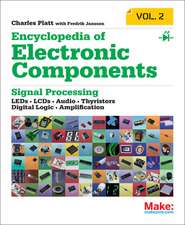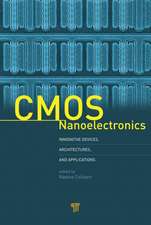The Emerging Domain of Cooperating Objects
Editat de Pedro José Marron, Stamatis Karnouskos, Daniel Minder, Aníbal Olleroen Limba Engleză Hardback – 24 ian 2011
These three types of quite diverse systems share a lot of commonalities on the one hand and, on the other hand, have some complementary aspects in common that make a combination of these systems into a coherent system vision promising. In particular, the important notions of control, heterogeneity, wireless communication, dynamic and ad-hoc nature and cost are prevalent to various degrees in each of these systems.
A future system concept needs to combine the strong points of all three system concepts in at least these functional aspects. It has to provide support for the control of physical processes like today’s embedded systems do, have as good support for device heterogeneity and spontaneity of usage as required by pervasive and ubiquitous computing approaches, and has to be as cost efficient and wirelessly agile as wireless sensor networks are. These new systems consist, therefore, of individual entities or objects that jointly strive to reach a common goal, which will typically be a goal in sensing or control, and are dynamically and loosely federating themselves for cooperation, taking care not to overtax their available resources.
This book presents a roadmap to these concepts which are summarized as cooperating objects.
| Toate formatele și edițiile | Preț | Express |
|---|---|---|
| Paperback (1) | 794.73 lei 38-44 zile | |
| Springer Berlin, Heidelberg – 14 oct 2014 | 794.73 lei 38-44 zile | |
| Hardback (1) | 804.58 lei 38-44 zile | |
| Springer Berlin, Heidelberg – 24 ian 2011 | 804.58 lei 38-44 zile |
Preț: 804.58 lei
Preț vechi: 1058.66 lei
-24% Nou
Puncte Express: 1207
Preț estimativ în valută:
153.98€ • 160.16$ • 127.12£
153.98€ • 160.16$ • 127.12£
Carte tipărită la comandă
Livrare economică 11-17 aprilie
Preluare comenzi: 021 569.72.76
Specificații
ISBN-13: 9783642169458
ISBN-10: 3642169457
Pagini: 250
Ilustrații: XXVII, 271 p.
Dimensiuni: 193 x 260 x 25 mm
Greutate: 0.76 kg
Ediția:2011
Editura: Springer Berlin, Heidelberg
Colecția Springer
Locul publicării:Berlin, Heidelberg, Germany
ISBN-10: 3642169457
Pagini: 250
Ilustrații: XXVII, 271 p.
Dimensiuni: 193 x 260 x 25 mm
Greutate: 0.76 kg
Ediția:2011
Editura: Springer Berlin, Heidelberg
Colecția Springer
Locul publicării:Berlin, Heidelberg, Germany
Public țintă
ResearchCuprins
Executive Summary.- Purpose of this Document.- Introduction to Cooperating Objects.- State of the Art in Cooperating Object Research.- Visions for Innovative Applications.- Market Analysis.- Research Roadmap.- Predominant Work Areas.- Summary and Conclusions.
Textul de pe ultima copertă
There are a number of different system concepts that have gained much relevance in the area of embedded systems over the past couple of years. First, there is the classic concept of embedded systems where the focus is on control systems for physical processes. Secondly, the notion of pervasive computing has evolved, where the vision foresees everyday objects having some form of computation capacity and, in most cases, sensing and communication facilities. Thirdly, the notion of wireless sensor networks has arisen, where small computing devices are able to sense their environment and cooperate in order to achieve a well-defined goal.
These three types of quite diverse systems share a lot of commonalities on the one hand and, on the other hand, have some complementary aspects in common that make a combination of these systems into a coherent system vision promising. In particular, the important notions of control, heterogeneity, wireless communication, dynamic and ad-hoc nature and cost are prevalent to various degrees in each of these systems.
A future system concept needs to combine the strong points of all three system concepts in at least these functional aspects. It has to provide support for the control of physical processes like today’s embedded systems do, have as good support for device heterogeneity and spontaneity of usage as required by pervasive and ubiquitous computing approaches, and has to be as cost efficient and wirelessly agile as wireless sensor networks are. These new systems consist, therefore, of individual entities or objects that jointly strive to reach a common goal, which will typically be a goal in sensing or control, and are dynamically and loosely federating themselves for cooperation, taking care not to overtax their available resources.
This book presents a roadmap to these concepts which are summarized as cooperatingobjects.
These three types of quite diverse systems share a lot of commonalities on the one hand and, on the other hand, have some complementary aspects in common that make a combination of these systems into a coherent system vision promising. In particular, the important notions of control, heterogeneity, wireless communication, dynamic and ad-hoc nature and cost are prevalent to various degrees in each of these systems.
A future system concept needs to combine the strong points of all three system concepts in at least these functional aspects. It has to provide support for the control of physical processes like today’s embedded systems do, have as good support for device heterogeneity and spontaneity of usage as required by pervasive and ubiquitous computing approaches, and has to be as cost efficient and wirelessly agile as wireless sensor networks are. These new systems consist, therefore, of individual entities or objects that jointly strive to reach a common goal, which will typically be a goal in sensing or control, and are dynamically and loosely federating themselves for cooperation, taking care not to overtax their available resources.
This book presents a roadmap to these concepts which are summarized as cooperatingobjects.
Caracteristici
Presents the quite new vision of Cooperating Objects Enables us to better understand the impact on the research landscapes Helps to steer the available resources in a meaningful way Includes supplementary material: sn.pub/extras
















